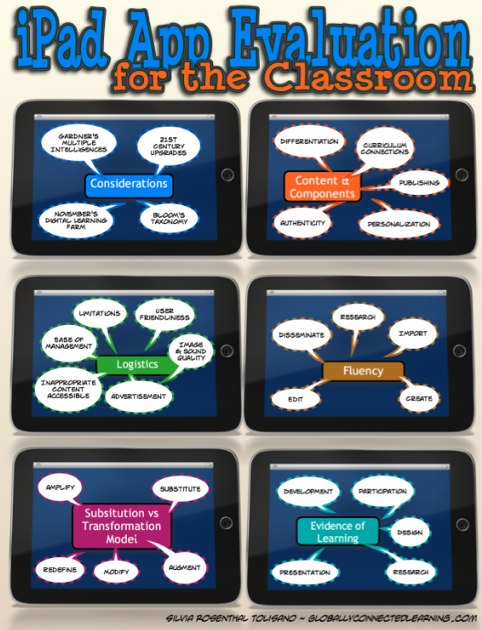Evaluating Apps with Transformative Use of the iPad in Mind

The app development market is exploding. More and more companies are creating “educational apps”. In some cases, they are simply digital versions of a book or a web based tool. Some seem to have “no educational value” to it at all, but are still sold under the label of “education”. Although, I usually don’t resort to borderline cuss words, I really liked the expression of “crapware”, Sarah Perez over at TechCrunch used when she was reviewing a new app for the Pre-School/Kindergarten crowd.
That being said, TinyTap is still a lot better than much of the kids’ apps crapware out there in the iTunes App Store. And it’s hard not to fall in love with the concept at the very least. Instead of burning up brain cells with the mind-numbing games out there, TinyTap enables kids to become game creators, not just players.
I have teachers ask me frequently about app recommendations for different subject areas.
- “What app could I use to teach subtraction?”
- “What app would you recommend for my students to practice writing?”
- “I want to use iPads in my Science class. What app is good for that?”
I usually sigh to myself, when I receive questions like that. While I am not against in suggesting apps ( which I love doing), I am not comfortable with the level of disconnect between the teacher (who knows her/his students best) and the curriculum related skills and objectives and pedagogical relationship that needs to be in place for an app to be a match to use in a classroom or with an individual learner.
I want teachers to be able to, not only ask for and use an app, because someone else recommended it, but I want teachers equipped with the curiosity and the knowledge of:
- the value an app can bring to a learner (and being able to articulate the value)
- the connection from the app to curriculum content (and being able to demonstrate the depth of that connection)
- the possibilities the app can bring in order to amplify (take a look at a previous post: The Next Step: Amplification )
- the difference of using an app to automate and substitute a task versus informate and transform (previous post: Enhancement-Automating-Transforming-Informating )
- how to evaluate apps for their transformative potential?
Without a doubt, educators using iPads in the classroom, are in new territory. The iPad made its first debut in April 2010 ( at the time of this writing, just a little over 2 years ago). There is no extended period of tried and tested roadmap….new apps are appearing daily… If you are using iPads in education, YOU are a pioneer.
We are in need to chart a new course, not merely following in the footsteps of the ones who came before us and not simply adapt the tools at our disposal to the “old way of doing things”.
Tools and ideas to transform education. Sign up below.
More importantly, we are in dire need of educators who are willing to use their imagination, experiment, revise a course of action, innovate and share their best practice in regards to using iPads in education.
I came upon the following rubrics (1) developed by Harry Walker and (2) based on Kathy Schrock and updated by Greg Alchin.
With the above rubrics as an inspiration, I created the following iPad App Evaluation for the Classroom info-flyer to be used by teachers to critically look at each app they are contemplating using with their students.
I am addressing the following areas, which are not meant to be exclusive for evaluating an app, but could be considered a starting point and a platform to build upon.

Please share in the comment section other areas, you consider important when evaluating apps for the classroom and, if applicable, please share a link to your own rubric or reflective post.
You can download the PDF file of the iPad App Evaluation for the Classroom.
- Considerations
- Content & Components
- Logistics
- Fluency
- Substitution vs Transformation Model (based on SAMR model of Ruben Puentedura and Alan November‘s work)
- Evidence of Learning (based on conversation with Stephen Wilmarth)
iPad App Evaluation for the Classroom
Further Resources:
